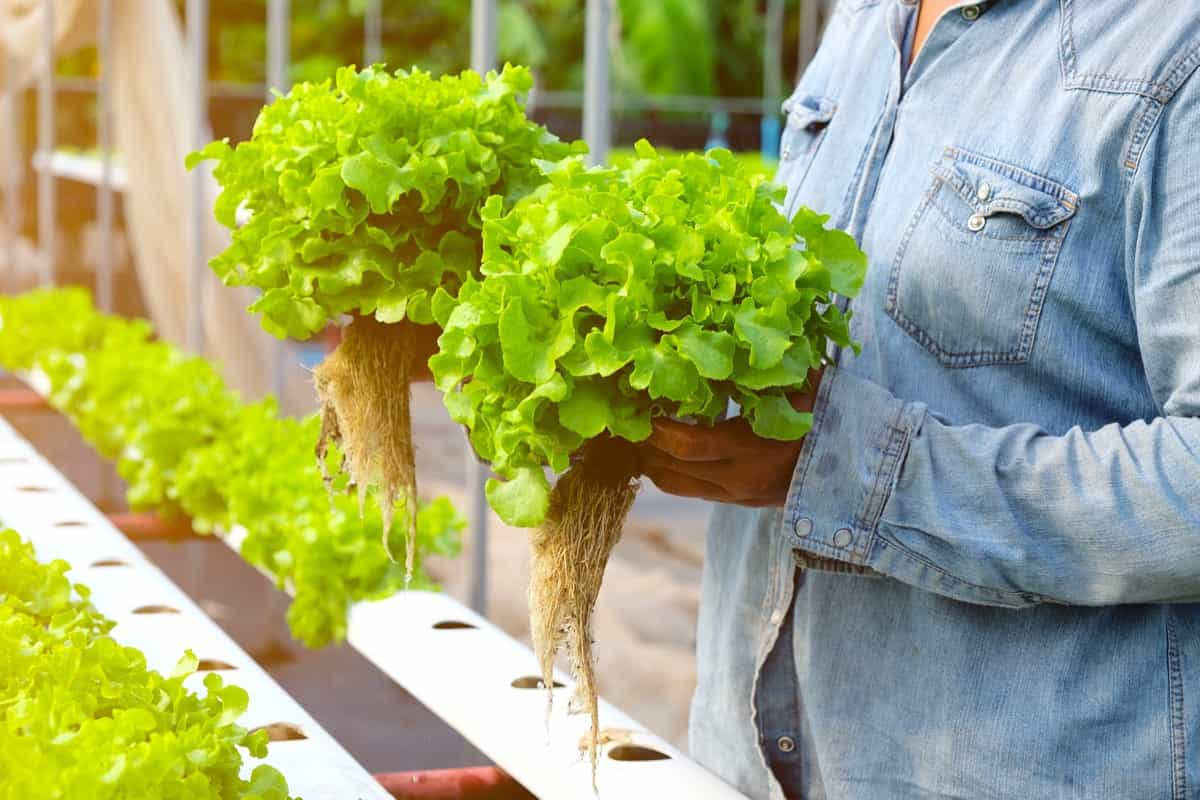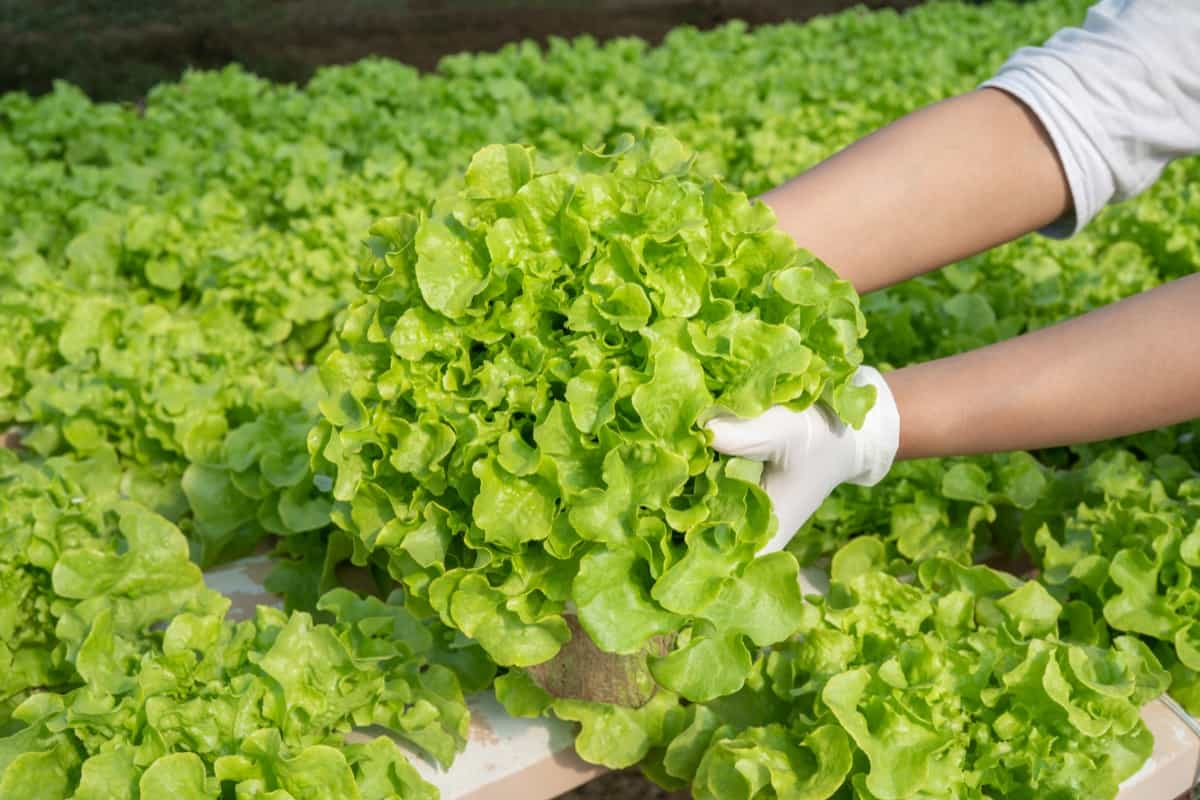Deep Water Culture (DWC) is a popular and pure form of hydroponics where plants are grown in a water-based nutrient solution, ensuring optimal growth conditions. This system is renowned for its simplicity, efficiency in water usage, and nutrient absorption. In this article, we’ll delve into the core concepts of DWC hydroponics and guide hobbyists and commercial growers on how to get started.

How Deep Water Culture Hydroponic System Works
Deep Water Culture (DWC): What Is It?
A hydroponic method called Deep Water Culture (DWC) suspends plant roots in a water-and-nutrient, well-oxygenated solution. Three crucial parts make up this solution:
- Oxygen: To keep the water well-oxygenated and prevent the roots from drowning since they are submerged in water, DWC systems employ an air pump and air stone.
- Water: DWC continuously gives the plants water, eliminating the need for conventional watering.
- Hydroponic fertilizer: Hydroponic fertilizers are supplied to the oxygen-rich water in this system, which does not have soil, to provide plants with the micro and macronutrients they need to grow.
The name “Deep Water Culture” is derived from the system’s use of a reservoir that holds a significant amount of water, ensuring stability in the nutrient solution. Additionally, most of the plant’s root system remains submerged in water 24/7, contributing to the system’s name.
Understanding the Basics of DWC Hydroponics
Deep Water Culture (DWC) hydroponics is a method of growing plants without soil by placing them in containers with their roots suspended in a nutrient-rich water solution. The basics of DWC hydroponics include a reservoir, net pots, oxygen, 24/7 water, and monitoring. The reservoir is a container filled with water mixed with nutrients, serving as a plant’s water and food source.
Net pots are containers with holes, allowing roots to grow into the water below. Oxygen is provided by an air pump and airstone, preventing suffocation of roots. The constant access to water and nutrients helps plants grow faster. Monitoring the pH level is crucial to ensure the optimal conditions for optimal growth.
How Deep Water Culture (DWC) Hydroponic System Works
Deep Water Culture is a term that says it all—you cultivate plants in deep water! This may initially seem a little suspect because many plants perish from overwatering. To stop root rot, a pump in a DWC hydroponic system circulates and oxygenates the water. However, this is fine with DWC hydroponics because the water is continuously oxygenated and rich in nutrients essential for plant growth. Water, liquid fertilizer, and oxygen comprise the nutrient solution filling the water reservoir where the plants are produced.
In the water reservoir, the plant’s roots are fully buried and may stay there for the growth cycle. The water is constantly oxygenated thanks to the air pump and air stone, which prevents the plants from drowning. One of its benefits is The quantity of water used in a DWC hydroponic system. Maintaining a stable nutrient solution for plant absorption in a reservoir with more water is easier. Gardeners will need to do less upkeep and supervision as a result.
When you start a plant from a seed and its roots come into contact with water, you will witness exponential development. Deep Water Culture technology, plants always have access to the right amount of water and nutrients. Cocoir mat made of coconut fiber. One growing material for a DWC hydroponic system is coconut coir.
Materials Needed
- Container or Reservoir: This is where the nutrient solution and plants will go. It can be a bucket, tub, or any waterproof container.
- Net Pots: These pots hold your plants and allow the roots to grow into the nutrient solution.
- Air Pump and Airstone: These provide oxygen to the plant roots in the water.
- Growing Medium: Something like clay pellets or rock wool to support your plants.
- Nutrient Solution: A mix of water and plant nutrients to feed your plants.
In case you missed it: How to Grow Hydroponic Cucumber: A Step-by-Step Guide

Merits of Deep Water Culture
- Low Maintenance: After installation, DWC systems require little upkeep.
- Rapid Growth: Compared to traditional soil gardening, plants grown in DWC systems typically grow more quickly.
- Simplicity: DWC systems are generally simple to assemble and have few moving parts.
Demerits of Deep Water Culture
- Fluctuations in Small Systems: Small DWC systems may experience large fluctuations in pH, water level, and fertilizer concentration.
- Challenges in calibration: It is simple to over- or under-calibrate small-scale systems.
- Deficiency in Oxygen Risk: Low-oxygen nutrition solutions may result from electrical outages or pump problems, potentially damaging the roots.
- Temperature Control: Keeping the water at a constant temperature can be difficult.
Plants Suitable for DWC
Many plants thrive in DWC, especially those that don’t require flowering. Popular choices include lettuce varieties, herbs, vegetables like tomatoes and peppers, and fruits like squash. Research has demonstrated that plants in DWC grow faster and larger and yield more than those in traditional soil cultivation. However, success depends on proper implementation.
Deep Water Culture Variations
The conventional approach requires a 5-gallon bucket, an air pump, an air stone, airline tubing, net pots, growing media, hydroponic nutrients, a pH control kit, and a PPM (parts per million) meter. The air pump oxygenates the water in the bucket, where plants are cultivated in net pots filled with a growing medium. The pH of the water is checked as nutrients are introduced.
- DWC recirculating: This more sophisticated design connects various buckets to a main reservoir. All the buckets’ nutritional solutions are circulated, eliminating the need for separate calibration and maintenance.
- Bubbleponics: This variety uses a water pump to top-feed nutritional solutions to the plants via drip lines, enhancing the germination and seedling period. This strategy accelerates early plant growth.
Recirculating Deep Water Culture (RDWC)
It is challenging to scale up with the conventional DWC because of its drawbacks. These drawbacks are eliminated with recirculating deep water culture, and commercial producers can employ the system. While recirculating DWC functions similarly to a flood and drain system, the nutrient solution is never truly removed from the system. The main benefit of this system is its ability to scale up since all that is needed to operate it is to add water, oxygenate the air, and calibrate the central reservoir. You can reuse or circulate the water and nutrients the plants need from one bucket to the next.
In case you missed it: The Difference Between Kratky and DWC Hydroponic Systems

Conclusion
In conclusion, Deep Water Culture (DWC) hydroponics involves growing plants in water filled with nutrients and oxygen. Plants sit in net pots above the water, and an air pump keeps the roots supplied with oxygen 24/7. This method is easy to set up and efficient but requires careful monitoring to avoid issues like bacterial growth. DWC can help plants grow faster and yield more than traditional soil gardening when done right.
- Feed Your Flock for Less: Top 10 Tips to Save on Chicken Feed
- Ultimate Guide to Ossabaw Island Hog: Breeding, Raising, Diet, and Care
- Hatching Answers: The Top 10 Reasons Your Chickens Aren’t Laying Eggs
- Eggs and Economics: Breaking Down the Cost of Raising Backyard Chickens
- Defend Your Greens: Proven Methods to Keep Iguanas Out of Your Garden
- Ultimate Guide to Cinnamon Queen Chicken: A Comprehensive Guide for Beginners
- Ultimate Guide to California Tan Chicken: Breeding, Raising, Diet, Egg-Production and Care
- Ultimate Guide to Marsh Daisy Chicken: Breeding, Raising, Diet, and Care
- 10 Types of Chicken Farming Businesses You Can Start for Profits